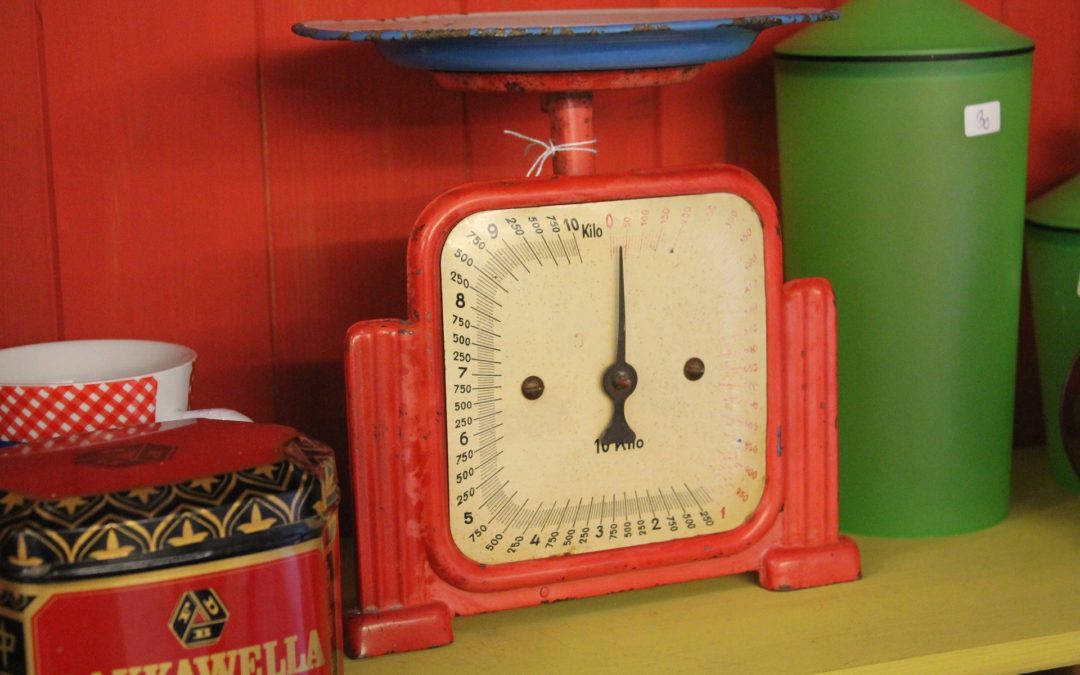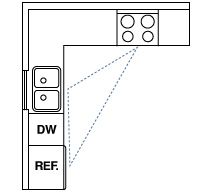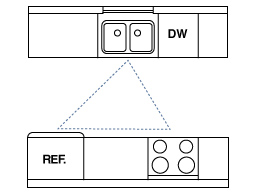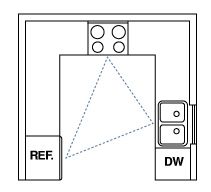Are you running a marathon in your kitchen in order to prepare meals?
Do you wish there was a more efficient way to work in your kitchen space?
Well, there is, and it’s called a work triangle.
Incorporate one into your kitchen design to ensure you have a space that functions for you today and help make life easier for you tomorrow.
It’s 70 Years Old!
Believe it or not, the kitchen work triangle concept was established back in the 1940’s as a way to help determine efficient kitchen layouts.
When the concept was created it was during the era when the kitchen was the domain of a single person, usually a housewife.
Luckily, things have changed since those stereotypical times, and so has home design itself. Nowadays you often have 2 (working) people sharing the cooking duties and the kitchen has become a place where guests are welcomed into, and is often a space for entertaining in.
The basic principles from the 1940’s however, are still at the root of the work triangle’s concept.
3 Primary Work Areas
The 3 busiest points in your kitchen are the sink, fridge and stove areas. Basic or gourmet meal preparation, baking, and clean-up are all a never-ending march back and forth between these points.
The three points and the imaginary lines between them, make up the kitchen work triangle.
The triangle is the shortest and most effective path between these areas and implementing it will save you thousands of steps over the years. For those of us who don’t revel being in the kitchen, it will also save us time so we can be doing the other things that we really love. As we get older we may suffer more from sore knees, bad backs, and other painful joints, and will be thankful for the shorter distances between the kitchen’s most utilized areas.
Efficiency is the triangle’s main goal, as it keeps all the major work stations near the cook, without placing them so close that the kitchen becomes cramped. You can expand or shrink the triangle depending on how many cooks there are, or even use 2 triangles in a particularly large kitchen, or to accommodate 2 cooks.
Work Triangle Guidelines
The “work triangle” is defined by the National Kitchen and Bath Association (NKBA) as an imaginary straight line drawn from the center of the sink, to the center of the cooktop, to the center of the refrigerator and finally back to the sink. The NKBA suggests these guidelines for work triangles:
- Each leg should measure between 4 and 9 feet.
- The sum of the work triangle’s three sides should not exceed 26 feet
- The work triangle should not cut through an island or peninsula by more than 12 inches.
- If the kitchen has only one sink, it should be placed between or across from the cooking surface, preparation area, or refrigerator.
- No major traffic patterns should cross through the triangle.
Kitchen Layouts Using the Triangle
In an L-shaped kitchen keep the sink between the fridge and stove for greater efficiency. The sink is the hub of the kitchen and is used often for food preparation as well as clean-up.
Galley kitchens are often the most compact design of all saving you from too many steps. They work well for solo cooks.
Large U-shaped kitchens may have a dining table or island in the middle of all the action. Make sure your work triangle is an uninterrupted line or you will add extra steps having to go around these center obstacles.
If you have a single line kitchen you could achieve a work triangle of sorts with an island or small portable table. Even if it’s a small one the extra work space would be welcome and will help make the space more efficient. TIP: Put a sink in this island to create the triangle.
Action Plan
Begin designing your new kitchen using the work triangle concept as a guideline in order to achieve a more functional kitchen. But don’t fret if the triangle concept doesn’t work out perfectly in your space. Sometimes no matter how hard you try, it just doesn’t work out.
For more tips on kitchen design go to the NKBA website and refer to their guidelines page.
Have you implemented a work triangle in your kitchen? How did it work out for you?




